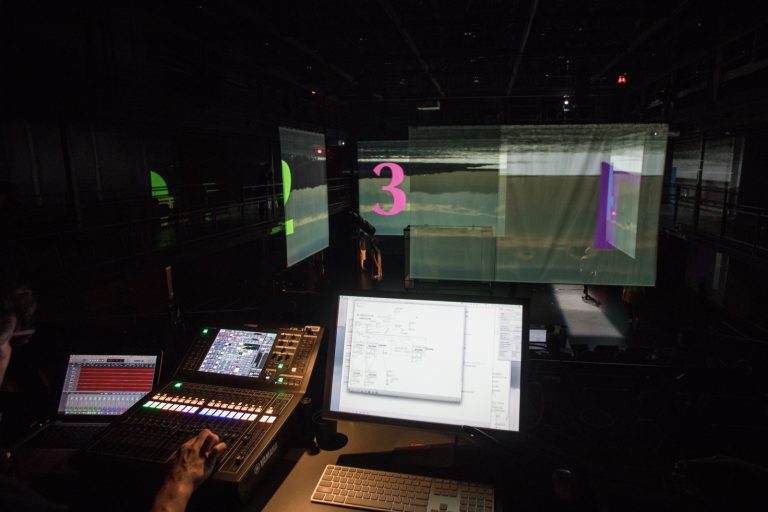Experiencing THE_OPER&
THE_OPER& is a computer-mediated work and a rich multimedia experience. Go behind-the-scenes of the second world premiere in the Ruby.

Three impressions from sitting in on a rehearsal of this ambitious new work by two Duke faculty members, commissioned and presented by Duke Performances:
1. A cool voice, embodied as a flickering white globe in a mobile steel-and-scrim framework, narrates serene self-examination—a train of observations and searching questions. Images of waterscapes move across the screens. The light is warm and so is the thrum of a sustained chord from a synthetic marimba that underscores the scene.
2. The monologue gives way to a dialog. The system’s ruminations alternate with snappy wordplay from a chorus of live performers, who trade words and short phrases like parts of a sentence in search of meaningful connection, backed by an insistent groove of pianistic chords and electronic rustles and thumps.
3. Chaos builds gradually but inexorably. The chorus loses its common purpose, fragmenting into solos and subgroups both in its singing and its pacing from one configuration to another on stage. As dissonance and disorder mounts, the flickering images becomes starker and whiter.
So it goes in THE_OPER& (“the operand”), a cutting-edge production by composer John Supko and media artist and “recombinant poetics” pioneer Bill Seaman—both Duke faculty members—with production design and direction by Jim Findlay and the Lorelei Ensemble as the cast. In each performance, according to the description provided by Duke Performances, “a computer system preloaded with video, sound, and poetic text fragments generates an original world, specific to the room and audience. That world eventually cedes to entropy, disintegrating from disaster and destruction until it falls into chaos, only to be rebuilt.”

The creators describe the piece as a “meta-tragedy”—each performance is a series of extended riffs on the nature and structure of tragedy. Talking to Dan Ruccia in Indy Week, they are more specific about the role of the computer as “an equal partner in the creative process.”
While Supko and Seaman determined the overall architecture of the work, the computer’s algorithms make all the moment-to-moment decisions, selecting which videos to show on the four screens that line the stage, which texts the computer speaks, and which section of Anna Barker’s choreography the singers will perform.
“Imagine if, at every decision point in an opera, there were between twenty and a hundred possibilities,” Supko says. “You have this constellation of possible outcomes and the meaning changes.”
In other words, the sequence of images and words I saw and heard will never happen again.
The piece is the first new work created for the von der Heyden Studio Theater in the Rubenstein Arts Center, and it makes superb use of a venue that is both intimate and expansive. The production features rich, detailed imagery, projected on screens surrounding the performance space. Thanks to the room’s open design and its height, the projections are a monumental presence. It would be a hard effect to duplicate in a performance space that separates the stage from the audience.

The importance of the visuals highlights the fact that this is truly a multimedia work, much more so than a typical opera. In spite of being a hybrid form, opera has not embraced multimedia in the contemporary sense. Supko thinks it should, and the reference to “opera” in the new work’s title is meant to send a message: “yes, ‘opera’ is a singular noun that comes to us from Italian, [but] it’s also a plural noun in Latin. The very word implies multimedia: ‘works’ of music, literature, dance, visual art/set design, etc.”
The unusually balanced role of music, text, and imagery is the product of an unusually balanced collaboration. Supko and Seaman are jointly responsible for the text and the sound samples played by the computer. Supko wrote the score for the singers and virtually all of the projected imagery is by Seaman.
In short, the team brings a unique mindset to this piece, and a radically new approach to the material of a musical drama. Because they elevated the role of the computer, they had to assemble material in a different way, thinking about the quality and impact of interchangeable imagery and sounds, and about the interplay and flow of language rather than fixed narrative. It was a painstaking process—according to Ruccia, “Supko and Seaman spent three years constructing the sonic, textual, and video databases that make up the work and determining its overall form.”
The effect in performance is fascinating.












